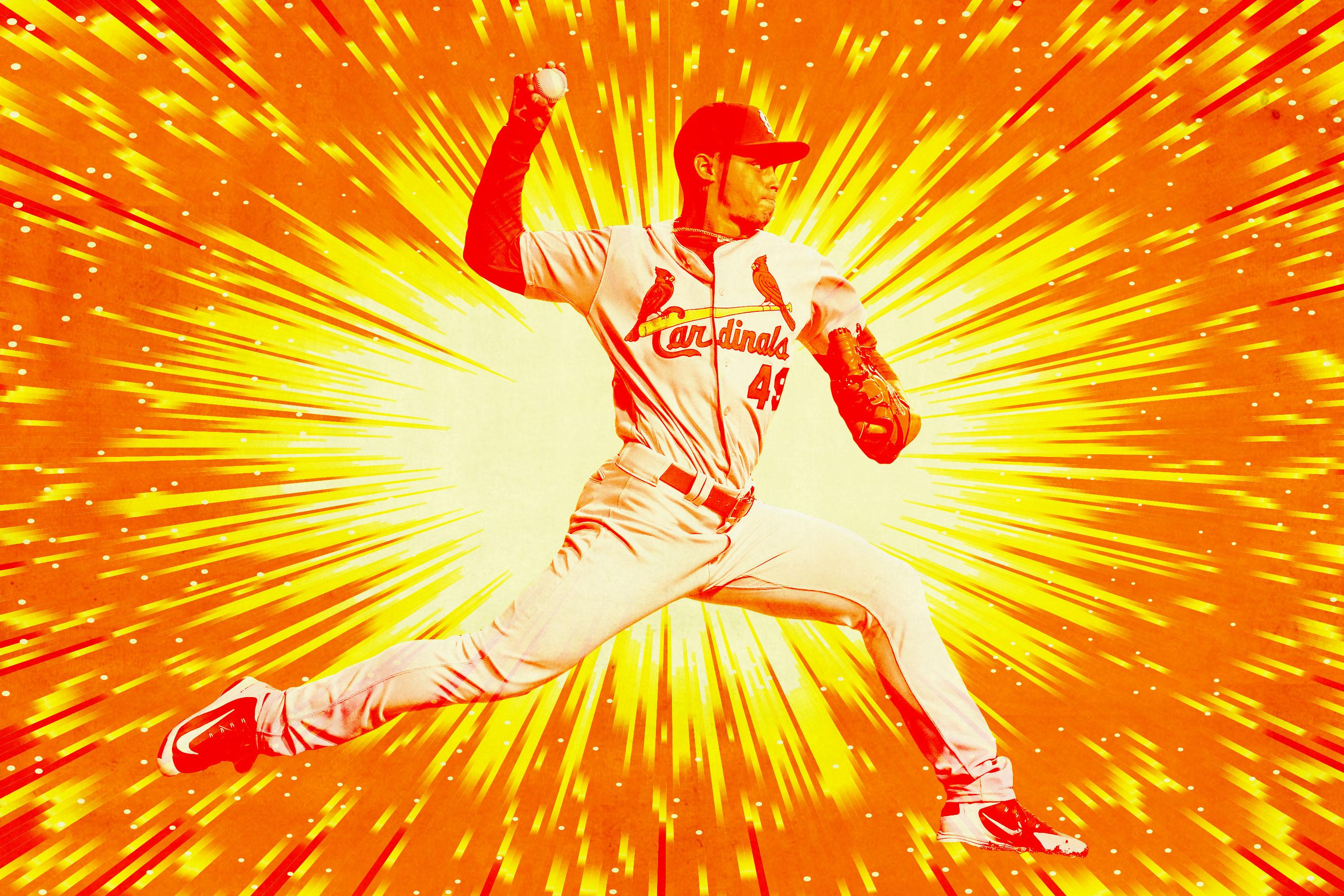
On May 20, Cardinals rookie reliever Jordan Hicks threw one of the most memorable balls of the season.
It wasn’t a good pitch—it was way outside, and far from its target—but it was an impressive pitch, and only partly because the zoomed-in, off-center angle made the sinker appear possessed. The pitch also impressed because of its speed: 105 mph. Many baseball broadcasts still flash flames on the chyron when a pitch touches 95. This pitch made a 95 mph fastball look like Mark Buehrle’s mid-80s gas. And it wasn’t a once-in-a-season or even once-in-an-outing event: Two pitches later, Hicks hit 105 again. The other three pitches that the Phillies’ Odúbel Herrera watched, waved at, or fouled off en route to a strikeout all rounded to 104.
Measurement error and changes in tracking technology make it tough to determine whether Hicks’s 105 or Aroldis Chapman’s similarly wild 105 from 2016 is definitively the fastest on record. It’s likely, though, that when this season is said and done, someone other than Chapman will have thrown the year’s fleetest fastball for the first time since 2009.
Compared with Chapman, who threw hard enough to turn heads in the 2009 World Baseball Classic and signed a six-year contract with Cincinnati the following January, Hicks, a 2015 third-round draftee, snuck onto the scene. He wasn’t a top-100 guy (aside from his fastball) on any preseason prospect list, and the last line on his minor league record was a 6.32 ERA in the Arizona Fall League, where he worked largely in relief. Baseball America ranked him fifth in St. Louis’s system this spring but warned about “below-average command and control.” His blurb in the BA Prospect Handbook reads, “Hicks has a chance to jump to Double-A Springfield in 2018, depending on his camp performance.”
Instead, he jumped directly to the big leagues. Hicks’s Chapman-rivaling heat drew attention beginning with his Opening Day debut, but before long, the righty’s appearances started to cause consternation as well as oohs and ahhs. Although Hicks’s stuff made him a marvel, his stats made him a mystery. Hicks fanned Herrera in their May 20 showdown, but that strikeout was only his third since April 14. At the end of that hard-throwing inning, Hicks’s full-season strikeout rate, in the midst of the sport’s strikeout peak, stood at 9.5 percent—or, to use a more traditional scale, 3.7 strikeouts per nine innings. In 22 innings, he’d recorded only 9 Ks, while walking 16 batters. No pitcher who’d thrown more than seven innings had a worse strikeout-to-walk ratio. Somehow, the pitcher who threw harder than anyone else was also one of the worst at whiffing batters, which didn’t make much sense.
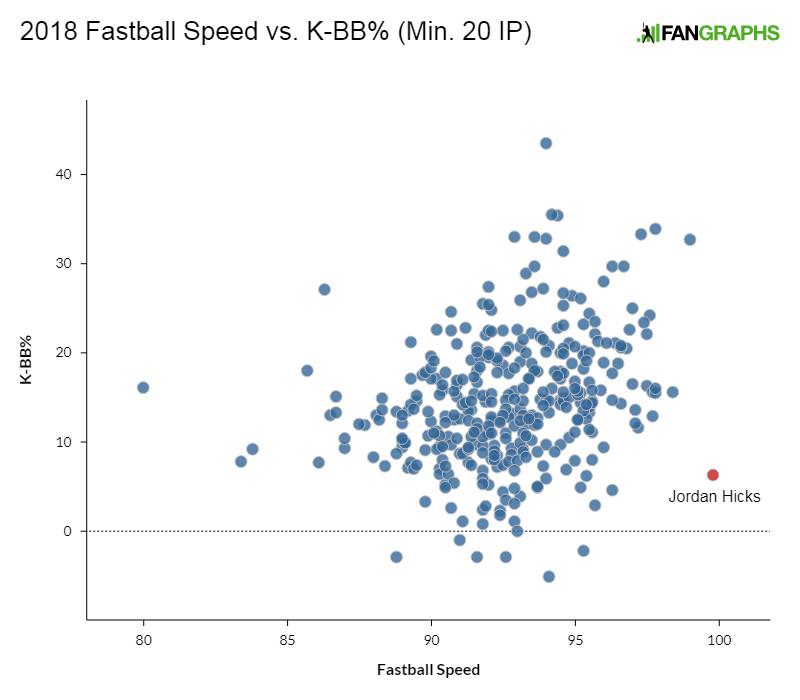
Granted, after his May 20 appearance, Hicks had a 2.05 ERA and a great groundball rate, but his success still seemed like something of a mirage. Advanced stats were much less sanguine about whether the formula could keep working: The gap between his expected and actual wOBA allowed was one of the biggest in baseball, and his average exit speed allowed was closer to the bottom of the reliever leaderboards than the top, which made his .194 BABIP look even less plausible. The question was whether experience could help him improve his peripherals before the walks and lack of Ks caught up to him.
Two days after Hicks released the blistering sinker that got him GIF’d, I talked to Michael Baumann about the reliever’s strange season on The Ringer MLB Show. “A guy who throws this hard, you can’t really teach that,” I said. “Hopefully you can teach the other stuff … some kind of control or feel for the breaking ball.” Later, we discussed Brewers reliever Josh Hader, who like Hicks had moved from a minor league rotation to the big league bullpen with little pen work in his past. After showing shaky command during his first month in the majors last season, Hader had lowered his walk rate and developed his slider into a swing-and-miss pitch. In that sense, I said, “He’s kind of what you hope Hicks might be someday.”
Hicks still isn’t Hader, but he is making a Haderlike leap. “At some point,” I concluded on the podcast, “Jordan Hicks is gonna be good.” In retrospect, that point has already arrived. Hicks’s ERA since May 20 is almost unchanged, at 2.08. But his FIP has fallen from 4.87 through that outing to 0.86 afterward, and his strikeout and walk rates have improved from 9.5 percent and 16.8 percent, respectively, to 40.4 percent and 6.4 percent. Among relievers with at least 10 IP from May 21 through June 12, Hicks’s FIP and xFIP were the very best in baseball.
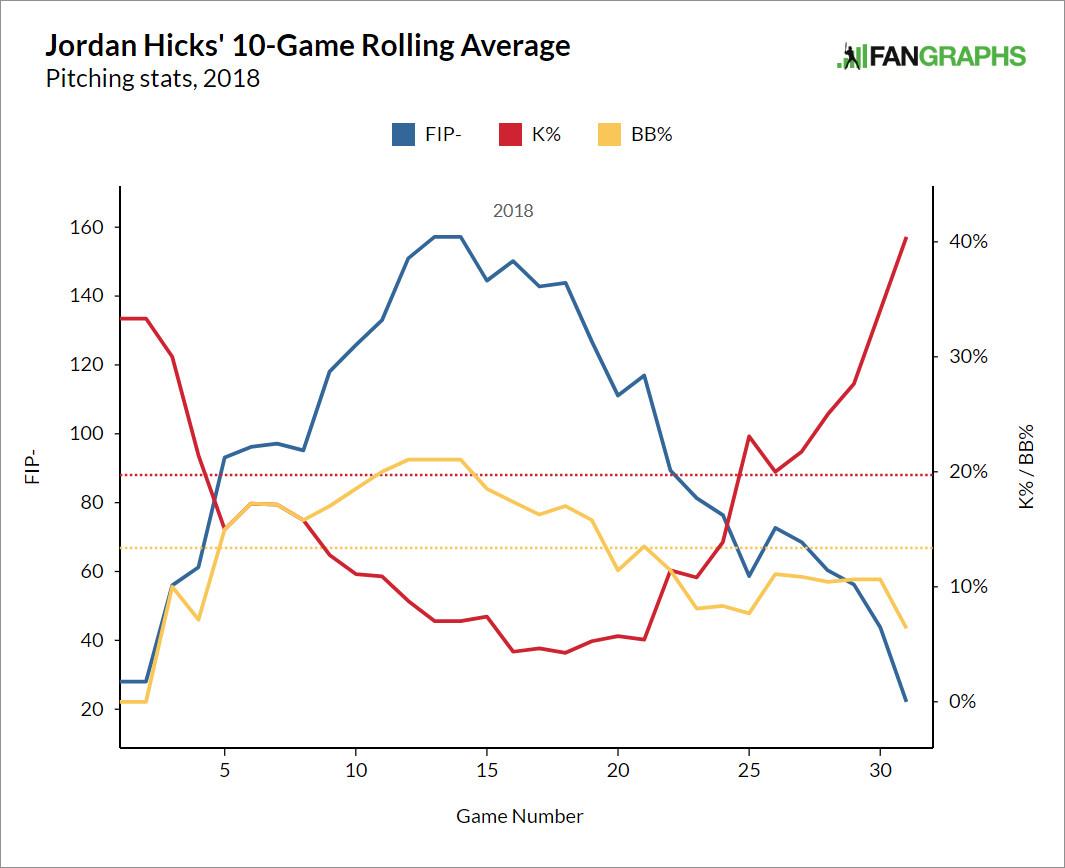
It’s a small sample, sure. But it doesn’t take too much convincing to believe that someone who throws as hard as Hicks does might be the real deal. Better yet, Hicks has made changes that support the improvement.
Amid his perplexing start to the season, Hicks had struggled to find the strike zone. Through May 20, he’d thrown only 43.6 percent of his pitches in the zone, well below the leaguewide full-season average of 47.9 percent. Hicks has thrown his sinker almost three-quarters of the time—more often than any other pitcher who’s racked up as many innings—and because sinkers are the sport’s most contact-prone pitch type, his strikeout hopes rely on his slider. Because his slider was wild, though, it wasn’t inducing swings: Through May 20, batters offered at only 29.7 percent of non-fastballs from Hicks, which put him in the fourth percentile among relievers who’d thrown at least 50 off-speed pitches. The rookie was the latest pitcher to prove the axiom that it takes more than heat to get the ball by big league batters.
All of that was about to change. In completing a perfect inning on May 23, Hicks struck out two batters for the first time since a two-inning April appearance, with both of the Ks coming on sliders—one swinging, one looking. The pitcher who’d barely been sniffing the strike zone went 7-for-7 on strikes.
After the game, Hicks felt that he’d found something. “That’s my go-to strikeout pitch,” he told reporters, referring to the slider, “but it just hasn’t been there lately.” In contrast with his previous outing, he said, he hadn’t strained to throw as hard as he could, taking two or three ticks off his still-fearsome fastball and focusing on command. “I’m just gonna go throw strikes,” he added, promising, “More strikeouts are going to come.”
The rookie was as good as his word. Prior to that May 23 outing, Hicks had thrown strikes on 58.9 percent of his pitches, which put him in the ninth percentile among all pitchers who threw at least 100 pitches in that period. From that outing on, he’s thrown 68.2 percent strikes, which puts him in the 86th percentile in that more recent sample. His zone rate has risen to an above-average 48.9 percent, and he’s also getting swings on non-fastballs almost twice as often: 58.5 percent of the time, which has bumped him up from the fourth percentile in that category to the 94th. It’s a remarkably rapid turnaround. A little more than a month ago, a Baseball Prospectus article called Hicks a “strikeout-scourge fix.” As it turns out, he’s the latest pledge in the fraternity of flamethrowers that’s sent strikeout rates skyrocketing.
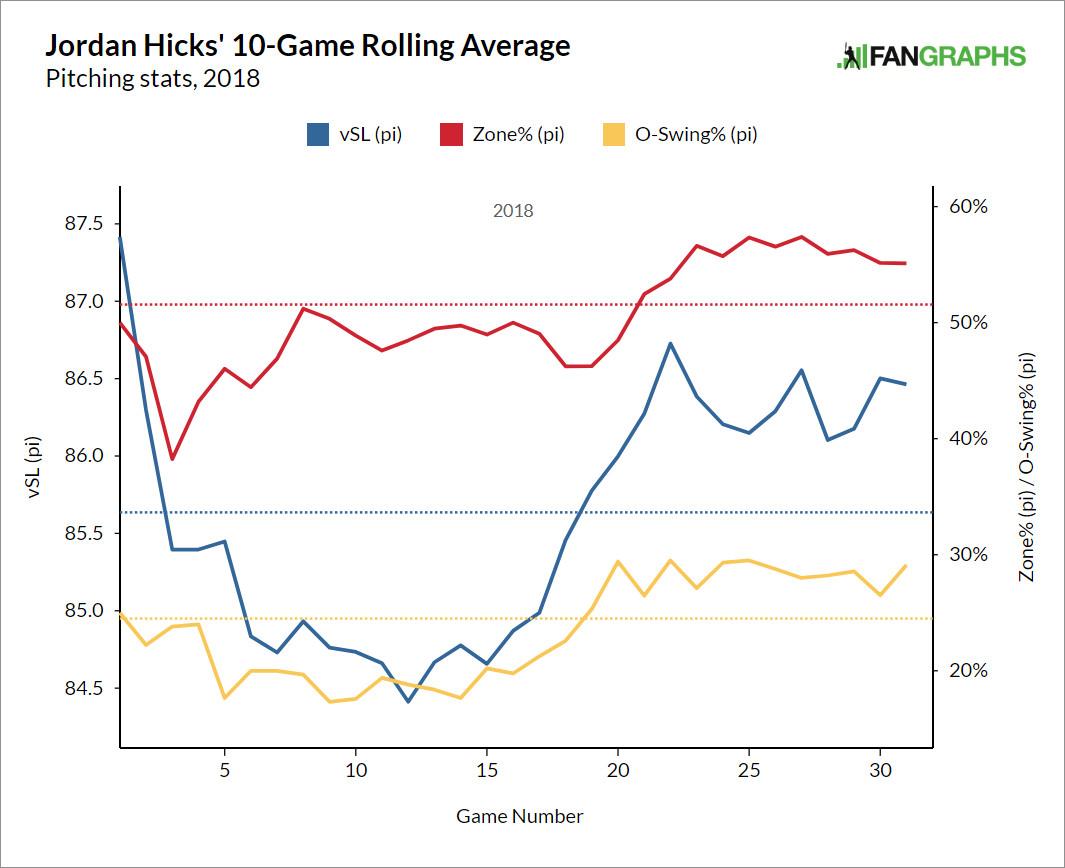
Since Hicks discovered his slider, he’s thrown the breaking ball significantly harder than before, and with less side-to-side movement; it’s now fast and tight, not slow and sweepy.
He’s also raised his sinker and slider release points by 2 to 3 inches and narrowed the gap between them by about an inch—thereby disguising the difference between pitch types—all while repeating those release points more consistently.
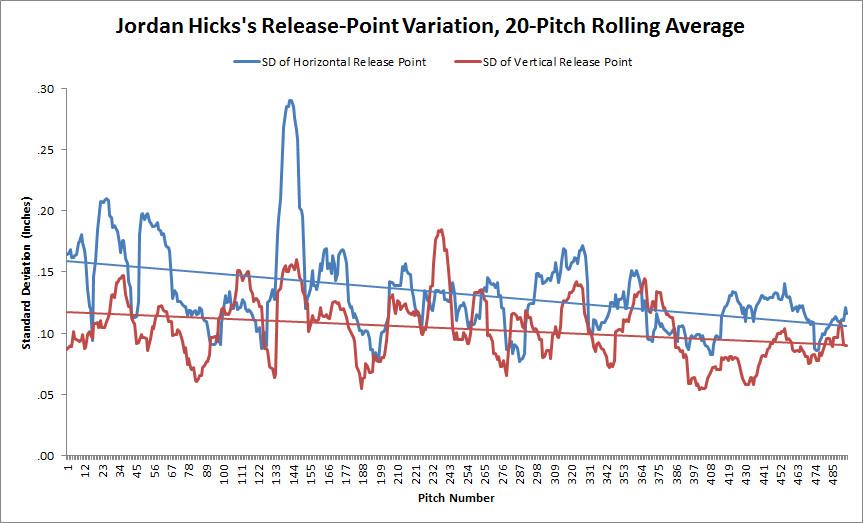
Location, of course, is the key, as the below before-and-after GIF of his slider destinations makes clear. Through May 20, Hicks sailed his sliders way high, left them over the middle, or buried them far from the plate. In his last 10 games, though, he’s kept his breaking balls lower and lived on the edges of the zone.
If Hicks stays healthy and maintains his newfound feel for his slider and the strike zone, he could be headed for a historic strikeout increase. Only 11 pitchers in MLB history who’ve faced at least 100 batters both before and after the end of May have posted strikeout rates of 15 percent or lower before June and 25 percent or higher from June 1 on. No pitcher with a pre-June K rate of 15 percent or lower has ever exceeded 29.5 percent thereafter. Hicks’s bid to be the first is off to an excellent start.
Post-May Strikeout-Rate Turnarounds
Sabathia in 2001 and Langston in 1984 were both raw rookies who went on to become big bat-missers after slow strikeout starts in the majors. Hicks seems to be following in their footsteps, albeit in the bullpen. If anyone were bound to become baseball’s most extreme midseason strikeout-rate raiser, it would be a 21-year-old rookie who skipped the upper minors, migrated from the rotation, and throws as hard as anyone ever has. Considering the hurdles he had to clear in his accelerated ascent to St. Louis, Hicks’s rookie growing pains didn’t last long at all.
Now we’ll wait to see not whether batters will break Hicks, but whether manager Mike Matheny will: Only two other rookie relievers have thrown as many innings as Hicks has this season, and both Ryan Yarbrough and Noé Ramirez are several years older and throw about 10 mph slower. If Matheny does ride Hicks too hard, it will be because the bullpen can be such an unpredictable place, and Hicks’s time-honored transition from “thrower” to “pitcher” has made him a dependable port in a disorienting storm. This is, after all, a world where one can wake up and discover that 31-year-old journeyman Justin Miller is suddenly a dominant arm. But at least we can declare one puzzling case closed: The phenom who hit 105 no longer has stats straight out of the deadball days. Jordan Hicks has a high strikeout rate, and the sport makes slightly more sense.
Thanks to Dan Hirsch of The Baseball Gauge for research assistance.

